Intel DX79SI Review: The Default X79?
by Ian Cutress on November 18, 2011 1:10 AM EST- Posted in
- Motherboards
- Intel
- X79
System Benchmarks
USB Speed
For this benchmark, we run CrystalDiskMark to determine the ideal sequential read and write speeds for the USB port using our 64GB Patriot SuperSpeed USB 3.0 drive. Then we transfer a set size of files from the SSD to the USB drive, and monitor the time taken to transfer. The files transferred are a 1.52 GB set of 2867 files across 320 folders – 95% of these files are small typical website files, and the rest (90% of the size) are the videos used in the Sorenson Squeeze test.
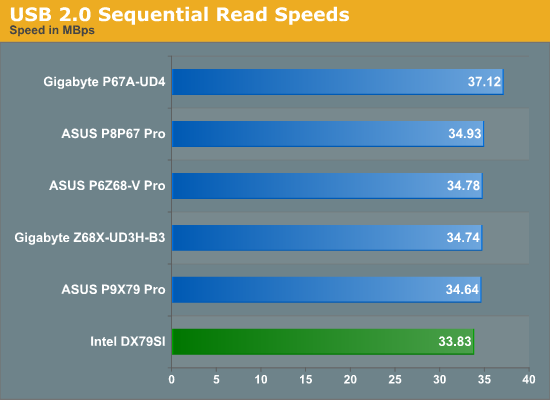

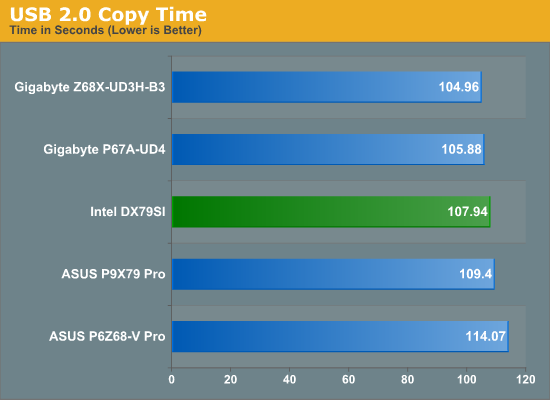
Despite the less than great sequential speeds, the Intel is board still as good as, if not better than, the ASUS P9X79 Pro.
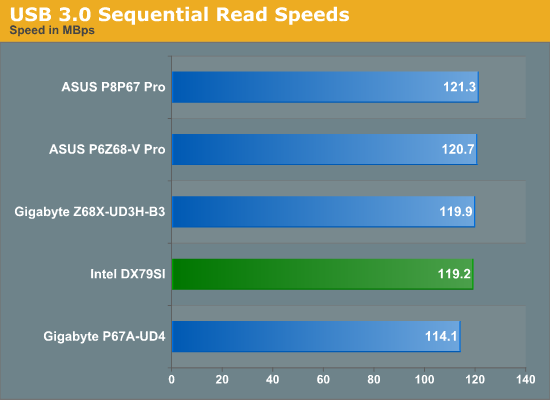
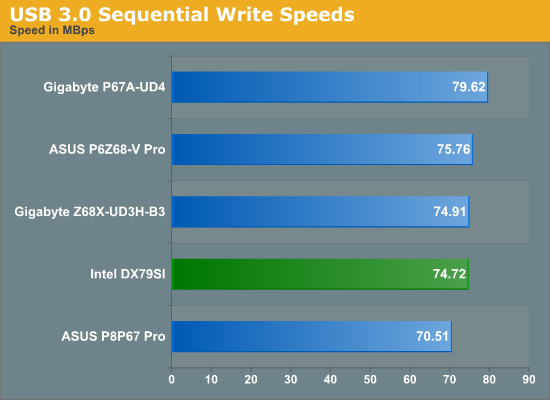
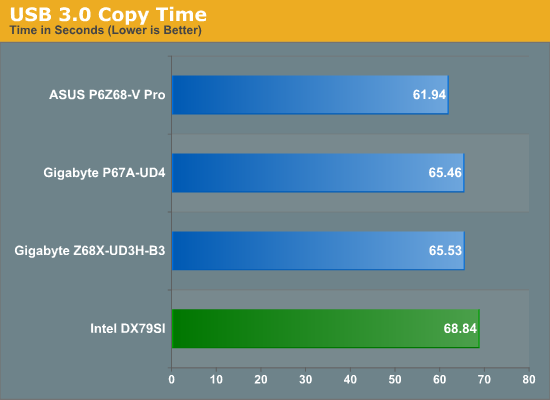
On the other hand, USB 3.0 speeds were relatively disappointing compared to previous chipsets.
SATA Testing
We also use CrystalDiskMark for SATA port testing. The operating system is installed on the Micron RealSSD C300, which is rated at 355 MB/s read and 215 MB/s write, and the sequential test is run at the 5 x 1000 MB level. This test probes the efficiency of the data delivery system between the chipset and the drive, or in the case of additional SATA ports provided by a third party controller, the efficiency between the controller, the chipset and the drive.


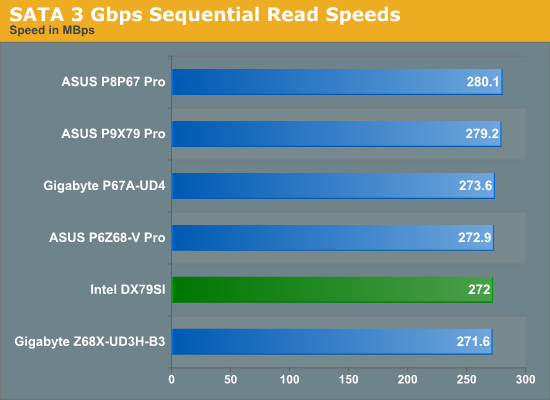
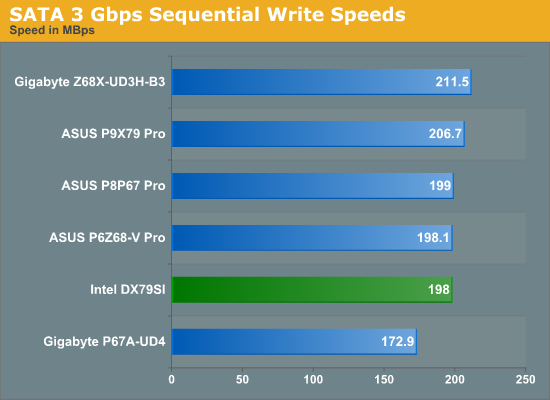
The dichotomy of the SATA results is relatively strange - while in SATA 6 Gbps the DX79SI performs well in sequential testing, the SATA 3 Gbps results are relatively low compared to others.
DPC Latency
Deferred Procedure Call latency is a way in which Windows handles interrupt servicing. In order to wait for a processor to acknowledge the request, the system will queue all interrupt requests by priority. Critical interrupts will be handled as soon as possible, whereas lesser priority requests, such as audio, will be further down the line. So if the audio device requires data, it will have to wait until the request is processed before the buffer is filled. If the device drivers of higher priority components in a system are poorly implemented, this can cause delays in request scheduling and process time, resulting in an empty audio buffer – this leads to characteristic audible pauses, pops and clicks. Having a bigger buffer and correctly implemented system drivers obviously helps in this regard. The DPC latency checker measures how much time is processing DPCs from driver invocation – the lower the value will result in better audio transfer at smaller buffer sizes. Results are measured in microseconds and taken as the peak latency while cycling through a series of short HD videos - under 500 microseconds usually gets the green light, but the lower the better.
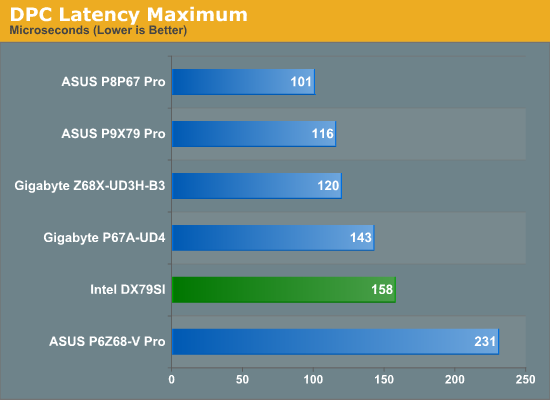
Our previous testing on the ASUS P9X79 showed that on average the DPC Latency was fairly low (~30 microseconds), with the occasional spike in the triple digits. On the other hand, the Intel DX79SI seemed to idle around double that of the ASUS board, with spikes into the 140-150s.










60 Comments
View All Comments
acompsys - Wednesday, November 30, 2011 - link
Check this out ....http://www.youtube.com/watch?v=z0uXWmlMOgg
mooninite - Friday, November 18, 2011 - link
*eye squint*Not sure if troll...
Alurian - Friday, November 18, 2011 - link
But does having a skull on a motherboard seem like a jinx to anyone else?DanNeely - Friday, November 18, 2011 - link
Intel used Skull Trail as it's ultra performance branding in the past; this I suppose is a hommage to it.halo37253 - Friday, November 18, 2011 - link
I have the intel DX58SO board sadly, got it in a used combo deal so not complaining about the price. Though the bios's tend to be riddled with problems and have problems OCing. While I can overclock my I7 920 to 4.2ghz on this board (pretty good clock but most boards can do it) at only 1.38V. But doing so brings on some of the bios or maybe even the motherboard itself. Can't have S3 sleep turned on at all because when you wake it up it resets the v-core back to stock and system freezes. Or sometimes it will hang at boot and just restart and boot fine or just take long time to post. System is fully stable intel burn test and 24/7 prime. At newest bios but that may be the problem, just really haven't felt like trying out a bunch of different bios yet. And poor placement of sata ports are a big let down as well.The Boards also tend to be made up of lower quality parts and tend to have less power phases. They also tend to have the least performance. I would have to go with a gigabyte motherboard, had the ep45-ud3p and loved it. Gigabyte boards are also known to be the best overclocking motherboards, what is important to me cause I like to have the best performance I can get with the lest amount of money spent.
Viceroy_Fizzlebottom - Friday, November 18, 2011 - link
Interesting, I've have the exact same motherboard paired with a core i7 920 and never have had a single issue with it.Samus - Friday, November 18, 2011 - link
I have an Intel X58 board with my i7-920 and its been solid as a rock for 3 full years. Of course it cost $300 back in 2008, but, honestly it was worth it. Even today my PC is faster than 95% of the market.Clorex - Friday, November 18, 2011 - link
Mentioned in the original i7 3960x review:"Users running dual-GPU setups can enjoy the fact that both GPUs will have a full x16 interface to SNB-E (vs x8 in SNB). If you're looking for this to deliver a tangible performance increase, you'll be disappointed:
Modern GPUs don't lose much performance in games, even at high quality settings, when going from a x16 to a x8 slot."
But here we see that the extra bandwidth for the second GPU really shows, with the X79s pulling ahead of the P67/Z68 in Dirt 3 and Metro 2033. Does this mean that X79 might make sense for multi-GPU setups?
halo37253 - Friday, November 18, 2011 - link
I think you would start to notice with 3-4 gpu setups.I would love to see a 3way for 4way sli on this board. like 3/4 580s in sli. Compare it to the old lga1366 in same 3-4 way sli setup. If you can try to get the old i7 and new i7 at the same clock so we can see how much performance per clock increases.
Denithor - Friday, November 18, 2011 - link
This would be an interesting test, to see how efficient these chips/chipsets are at managing the overhead from 3-4 GPUs.